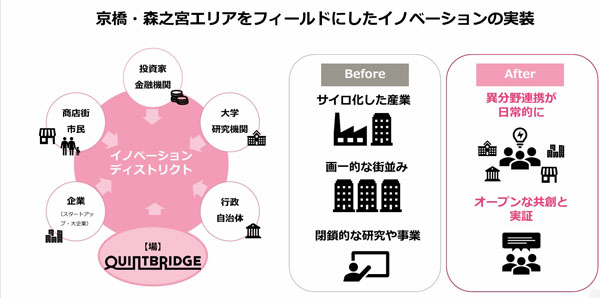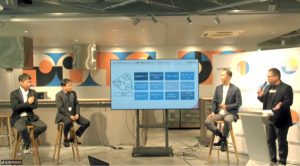Quintbridge, a space for co-creation, celebrates its third anniversary NTT West

Quintbridge, an open innovation facility operated by NTT West, celebrated its third anniversary on Monday, March 24th.
The company held a results report meeting to commemorate the third anniversary of its opening on Monday, April 21st.
Quintbridge currently has about 25,000 individual members and 1,895 corporate members, including companies and local governments. The total number of users has exceeded 250,000, and an average of more than 300 people visit Quintbridge every day. Co-creation events and programs are held about 450 times a year. 70% of these events are realized by members themselves bringing in their own themes, suggesting that Quintbridge has become established as a space for co-creation over the past three years.
In fact, a total of 115 business cases have been created over the past three years. NTT West is involved in around 30 of these projects.
In October last year, the company was awarded the 2024 Good Design Award in recognition of its creation of a unique ecosystem that emphasizes diversity and its facility management that focuses on social capital.
At the beginning of the results presentation, President Ryota Kitamura said, “Although Quintbridge is operated by NTT West Japan, we are on the same level as other members, and we have thoroughly created a place where companies, local governments, universities, startups, and citizens can co-create in an open and flat manner. In the future, we aim to contribute to the revitalization of the region and the entire Kansai region. Our big challenge for the fourth year is the Innovation District concept. It is an ambitious concept to evolve the entire Kyobashi-Morinomiya area into a city where innovation is linked together with all members. There are areas in other regions where companies and research institutions are concentrated, but there is not much horizontal collaboration. With Quintbridge as a hub, collaboration between different fields will occur on a daily basis, and companies and students will work together to solve the issues and themes of shopping districts and local residents. We want to start a movement for town development like that.”

パネルディスカッション(Panel discussion)
At the results presentation, a panel discussion was also held on the theme of the Local Innovation District concept, with the town development of the Kyobashi-Morinomiya area at its core.
Naoki Ichihashi, head of the Innovation Strategy Office at NTT West Japan, Teppei Shimokawa, an open innovation designer at the same company, Norifumi Fujimura, special vice president of Osaka Public University, and Takuya Samejima of the urban development support organization ONE Kyobashi Project took to the stage to discuss their vision for the new challenge.
Regarding the Local Innovation District concept, Ichihashi said, “Innovation in the past 50 years has often been carried out in the suburbs, with universities at the center, but in the past 10 years, movements in urban areas have been attracting global attention. Specifically, it is an area that can be traveled in about 15 minutes, where companies, government, universities, and local residents can innovate while maintaining close communication, and it is attracting attention as a form of next-generation open innovation. For example, in Boston, universities are leading the way, in Seattle, Microsoft is leading the way, and in Singapore and Israel, the government is leading the way. Another point is the ease of living for students and young startups.” He went on to explain, “The Kyobashi/Morinomiya area has everything, such as universities, companies, government, and shopping streets, and has great potential.”
Shimokawa said, “We have been exploring various ways to do this over the past three years, and one idea we have is to conceive and develop a regional revitalization business development challenge program. We want to create a program in which the issues and themes that local people have are handed over to the business development team (such as Quintbridge members), and a mixed team of companies and students tackles the issues. It would be great if this program could create a business that solves local issues, but essentially, we believe that the process of students and young entrepreneurs moving around the region is what solves local issues.”
Fujimura said, “If students have a place where they can settle as their base, they will naturally find social issues and connect them to the future society. Students these days are very serious. Because they are worried about the future, they have a strong desire to do their best. Therefore, they tend to think that if they work with local residents, they might be able to write something on their application form. However, that is not really the case. I think it is more important to create something that non-serious students think of than the efforts that serious students are trying to make.”
Samejima said, “We will be holding the Kyobashi Shopping Street Festival starting this summer. Kyobashi Central Shopping Street is on the outskirts of Kyobashi, so foot traffic was an issue. How can we get people to come? I think it will become more lively if we can hold an event together with students.”
※Translating Japanese articles into English with AI
